Lundahl Plate Chokes
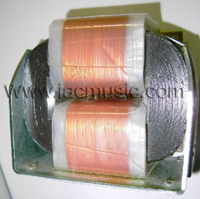
LL1667 Plate Choke
There are four types of plate chokes available: |
|||
LL1667 |
LL1668 |
LL2743 |
Power Supply chokes |
| High to medium impedance applications. | Medium to low impedance applications | Low Impedance applications | For low impedance applications (usually output stages), also the power supply chokes can be used. |
| Current 5..25mA Used rather at the low end of this range |
Current 5..25mA |
Current 40..90mA | 100mA or more. |
Why using a plate choke.
A plate choke can be used in a parafeed design, or replace the anode resistor in an amplifier stage. Some exotic ways exist as well, but these two applications, count for most of what we see.
- With parafeed, the DC component is dumped into the choke, while the AC component is tapped via a capacitor, making the output transformer, free of the DC current, work much better. So it can be smaller size, and yet frequency range is larger. That is in a nutshell, why plate chokes are used.
- With an amplifier stage, there is no longer this nasty load of the anode resistor. The choke itself is no AC load. This increases the gain, and most of all reduces distortion.
Select a plate choke.
For a quick, first choice, understand that a low current tube is always a high impedance tube and vice versa. All you need to do, is match the DC current of the choke to the tube. So not oversize it. This make the choice usually already correct. Most of all, because requirements to the plate choke itself are small. For AC, it's only function is to have high impedance. For DC it must have low resistance, but that is only to prevent voltage drop of the power supply voltage. Which drop is small anyway. For the rest, the DC resistance plays no big role. So as long as the choke can do the DC current, and as long as inductance is high enough to cause no low frequency drop in the audible range, this choke can probably be used, and you only need to fine-check it. Read the next text part for this.
Design example with 12AU7 / ECC82
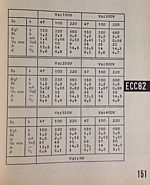 Here is an example of how to use the 12AU7 (ECC82) with a plate choke. The datasheet will give this data: Ia=10.5 mA at 250V Anode Voltage. Gain is 17x and Ri=7k7. So far so good. When trying to making a resistor loaded circuit like this, you will find out, it doesn't give the gain of 17x. Moreover you will find, output voltage is disappointing and distortion is high. We cannot begin texts here about how to design amplifiers, but just click on the picture and you will see the result at 250 Volt: Gain is 14x, and and distortion is 6.4% at maximum 34 Volt RMS signal. So all on all not exceptionally good. The reason for this is, the anode resistor of 47k....220k, needed to bias the tube as required. This resistor is a compromise, and the source of the low performance. Due to this resistor, you cannot choose the working point in an ideal area of the curves, and you get compromised by distortion and lack of maximum signal. Furthermore the resistor is a load for the tube signal, and this reduces it's gain. Frankly speaking all of the things we wanted from the tube, are compromised. Of course there are many cases where this is no problem. However, this becomes a problem when high signal is needed at low distortion. This is where a plate choke comes in.
Here is an example of how to use the 12AU7 (ECC82) with a plate choke. The datasheet will give this data: Ia=10.5 mA at 250V Anode Voltage. Gain is 17x and Ri=7k7. So far so good. When trying to making a resistor loaded circuit like this, you will find out, it doesn't give the gain of 17x. Moreover you will find, output voltage is disappointing and distortion is high. We cannot begin texts here about how to design amplifiers, but just click on the picture and you will see the result at 250 Volt: Gain is 14x, and and distortion is 6.4% at maximum 34 Volt RMS signal. So all on all not exceptionally good. The reason for this is, the anode resistor of 47k....220k, needed to bias the tube as required. This resistor is a compromise, and the source of the low performance. Due to this resistor, you cannot choose the working point in an ideal area of the curves, and you get compromised by distortion and lack of maximum signal. Furthermore the resistor is a load for the tube signal, and this reduces it's gain. Frankly speaking all of the things we wanted from the tube, are compromised. Of course there are many cases where this is no problem. However, this becomes a problem when high signal is needed at low distortion. This is where a plate choke comes in.
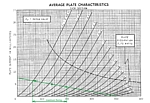 This is the marked operating point of the data table above here. This requires a Vb of 400Volt, but at least we can get 59V RMS that way. The construction is done only quickly by hand, so for precise data, read it from the data table. The intention is only to display it graphically.
This is the marked operating point of the data table above here. This requires a Vb of 400Volt, but at least we can get 59V RMS that way. The construction is done only quickly by hand, so for precise data, read it from the data table. The intention is only to display it graphically.
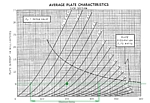 Here we take also a 5mA working point, but this time with a plate choke. Since the plate choke has the ability to generate a reversed voltage, effectively we work at twice the Vb. This is interesting, but you need to realize it. So you see here the bias point is with 200V across the tube, and 5mA Plate current. The required choke is LL1667-5mA. The choke has 2400 ohms DC resistance, so 12 Volt drop. It means we need a Vb of 212 Volts only. And not 400Volts as with the resistor design. Also, now look at the maximum signal swing, I read 275V peak to peak, so 97Volt RMS. It has almost doubled, and can be increased much further by simply shift the bias point further to the right. Now comes the nice thing for distortion, at the SAME output voltage of 59 Volts, distortion will be significantly lower as with the resistor design. The gain is unaffected, there is no load, so gain stays 17x.
Here we take also a 5mA working point, but this time with a plate choke. Since the plate choke has the ability to generate a reversed voltage, effectively we work at twice the Vb. This is interesting, but you need to realize it. So you see here the bias point is with 200V across the tube, and 5mA Plate current. The required choke is LL1667-5mA. The choke has 2400 ohms DC resistance, so 12 Volt drop. It means we need a Vb of 212 Volts only. And not 400Volts as with the resistor design. Also, now look at the maximum signal swing, I read 275V peak to peak, so 97Volt RMS. It has almost doubled, and can be increased much further by simply shift the bias point further to the right. Now comes the nice thing for distortion, at the SAME output voltage of 59 Volts, distortion will be significantly lower as with the resistor design. The gain is unaffected, there is no load, so gain stays 17x.
Conclusion:
When constructing the load line, in it's own way, this method will show you the benefit of using a plate choke. There is no more resistor load, and the load line is just a horizontal line. The movement along such a line, means the signal sweep stays away from this nasty area of high voltage, low current, where the distortion of every tube is highest. Also the distance between crossings of this load line, witch each tube curve, has the highest uniformity. Which minimized distortion also at high signal sweep. And.... all of this works nice even at low Vb.
As a result, gain is higher, maximum output signal is higher, and distortion is lower. So basically, all the good things we expect from a driver stage, we are getting this.
Though plate chokes are specified @ ~RMS, and power supply chokes @ ~100Hz ripple, they are identical core and construction, and full audio range always. In case voltage loss is a problem, lower resistance type exists. For convenient selection, we have put them all here in one table, first sorted by mA, then by Henry.
Connection of two coils |
Maximum DC current at full AC signal |
Maximum DC current at very low full AC signal |
Henry |
Signal |
DC resistance |
Dimensions (mm) and weight |
|
Series |
5mA |
8mA |
810H |
Max 390V,RMS. |
2400 Ohms |
45 x 63 x 73 (0.7kg) |
|
Series |
7mA |
11mA |
580H |
Max 390V,RMS. |
2400 Ohms |
45 x 63 x 73 (0.7kg) |
|
Series |
10mA |
16mA |
405H |
Max 390V,RMS. |
2400 Ohms |
45 x 63 x 73 (0.7kg) |
|
Series |
15mA |
25mA |
270H |
Max 390V,RMS. |
2400 Ohms |
45 x 63 x 73 (0.7kg) |
|
Series |
20mA |
33mA |
200H |
Max 390V,RMS. |
2400 Ohms |
45 x 63 x 73 (0.7kg) |
|
Series |
25mA |
40mA |
168H |
Max 390V,RMS. |
2400 Ohms |
45 x 63 x 73 (0.7kg) |
|
Series |
25mA |
40mA |
100H |
Max 285V,RMS. |
680 Ohms |
45 x 63 x 73 (0.7kg) |
|
Series |
70mA |
110mA |
64H |
Max 450V,RMS. |
400 Ohms |
50 x 75 x 95 (1.4kg) |
|
0,8mA |
540H |
Grid Choke |
5300 Ohms |
![]() Is it possible to exceed the maximum plate current? In many cases, the answer is YES! Please CLICK HERE to read more about it.
Is it possible to exceed the maximum plate current? In many cases, the answer is YES! Please CLICK HERE to read more about it.
More Advantages:
Not so well known is, a low quality plate choke may easily pick up hum from the mains transformer, which may become audible. When made from a single coil, in fact it becomes a huge pick up coil with very many windings. For this reason, the Lundahl plate chokes are always made of two coils which are in series (in phase) for the electrical signal, but they are placed such that they are out of phase for any magnetic signal picked up by the magnetic core. This prevents the Lundahl plate pick up any hum signal, even though such a magnetic (hum) field is always present at a certain level. This technology was adopted from the input signal transformers, and it works for a plate choke as well.
Technology:
Lundahl plate chokes have a windings technology with maximum sectioning. What does that mean? Plate chokes are made of very thin wire. Suppose you have 4000 windings. You can section it as two coils of 2000, or as 10 coils of 400, etc. You reach a limit, since the smallest section is one layer of single wire. It is just this what Lundahl is doing, and as far as we know they are the only one.
Note, they use the Audio Grade (high frequency) cores + inter sectioned layering also for the chokes. What does this mean? With LUNDAHL, all PLATE chokes can be used as POWER SUPPLY chokes and vice versa.
Detailed pictures of LL1667-7mA plate choke. All plate chokes are constructed this way
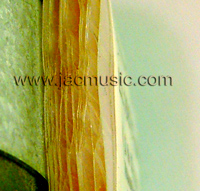 Here you see how extremely fine the sectioning is done. You have to look here for a full resolution picture, and you will see the foils are there like the pages of a closed book. Each foil you see represents one layer of very fine wire.
Here you see how extremely fine the sectioning is done. You have to look here for a full resolution picture, and you will see the foils are there like the pages of a closed book. Each foil you see represents one layer of very fine wire.
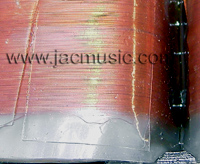 This picture is the outside (final) layer. Click here to see the detail. So this shows you best the coil is not a randomly wound package, as with low cost chokes. This reduces capacitance.
This picture is the outside (final) layer. Click here to see the detail. So this shows you best the coil is not a randomly wound package, as with low cost chokes. This reduces capacitance.
 Here you can see they double the sectioning by splitting the coil in two. As you can see the core is almost round shaped. So here all good things of the technology of ring-core is combined with the technology of C -core.
Here you can see they double the sectioning by splitting the coil in two. As you can see the core is almost round shaped. So here all good things of the technology of ring-core is combined with the technology of C -core.
Remember a plate choke is not only for increasing the gain of a tube, it also is very elementary in reducing the tube distortion. (It changes a tube from a not-so-ideal current source into an almost ideal one) So this MUST be a highest quality element, and we think Lundahl made exactly what we need: The BEST.
The symmetrical construction also results in lowest mechanical noise, since the two coils work with opposite orientation to each other. Detailed picture